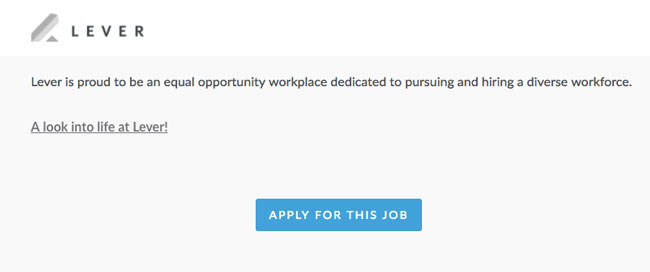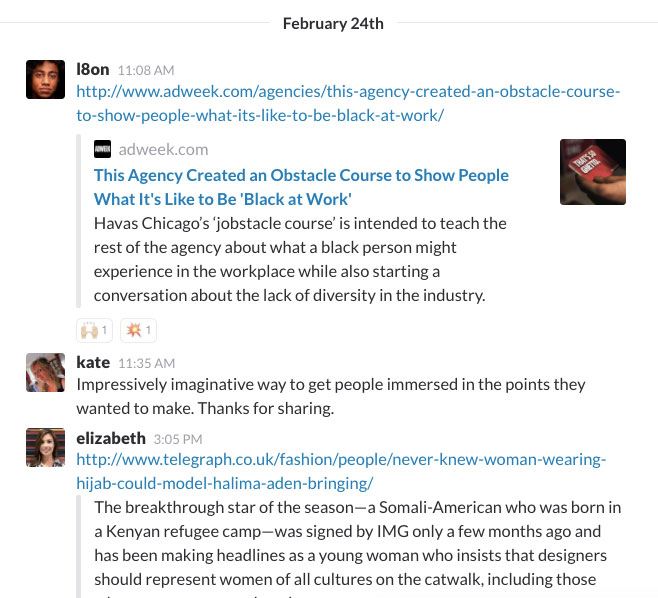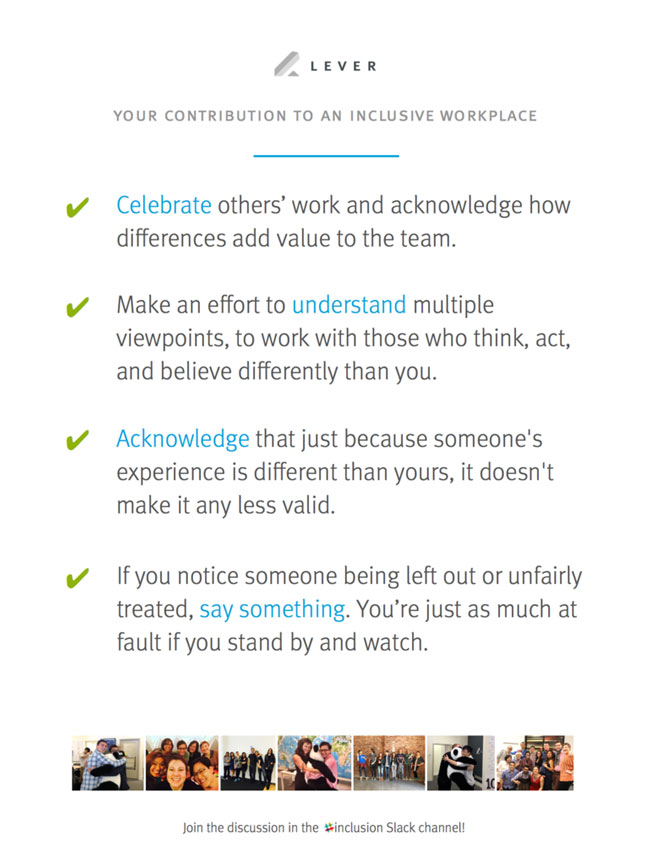
Nobody’s ever said that diversity and inclusion work is easy. But having grown a team that recently hit a 50:50 gender ratio (an uncommon feat, especially in Silicon Valley), I can let everyone in on a secret: It’s not rocket science, either.
The key is starting. And the earlier the better – the longer you wait to build a diverse workforce and inclusive culture, the harder it will be in the future.
Perfection isn’t the goal. It’s better to take your first steps toward prioritizing this type of culture work – even if you don’t have the exact “plan” or resources in place – than to lose any more time *not* making your company the kind of workplace anyone can be proud of.
To help companies get started today, I’m excited to share over 50 of the ways we’ve invested in diversity and inclusion at Lever. Understandably, every team worries about headcount, budget, and bandwidth, but diversity and inclusion should – and more importantly, can – be a priority in resource-strapped companies.
So much of what it takes to cultivate a diverse and inclusive workplace is about approaching tasks every company has to do anyway, but in much more a thoughtful and deliberate way. Here’s what we’ve done, and you can too:
1. Convert all job descriptions to gender-neutral language. Audit all of your JDs to check for any use of ‘he/his/him’ as a default and convert them to gender-neutral pronouns like ‘he or she’ or ‘they’. Text.io is a fantastic platform for this, as well as this quick app you can copy-paste your JDs into.
2. State your commitment to building a diverse and inclusive culture in your job descriptions and careers page. One simple sentence can send a strong message to your applicants.

3. Write results-based job descriptions. Studies have found, men apply for a job when they meet only 60 percent of the qualifications, but women will only apply when they meet 100 percent of them. Instead of being based on a checklist of skills that may weed great female and minority candidates out, JDs should ideally focus on what a candidate will be expected to achieve, say, a month, six months, and a year into the job. Here are some examples you’re welcome to adapt.
4. Diversify your pipeline by actively sourcing candidates. Push yourself and team to go beyond the “obvious” sources and aim to send one email or set up one coffee per week with a different type of profile. You might end up uncovering a gem who may become a star employee months later.
5. Conduct blind screenings to minimize unconscious biases in the resume review process. Studies have shown that people with ethnic names need to send out more resumes before they get a callback, and that resumes with female names are rated lower than ones with male names when all other things on a resume are equal.
6. Ban “culture fit” as a reason for rejecting a candidate. When interviewers want to reject candidates for “culture fit,” or a “gut feeling”, it’s an indication that unconscious bias is at play. Challenge your interviewers to articulate a more specific explanation – it’s a great way to uncover hidden biases and have open conversations about them (never punish or shame people – we are all inherently biased a little bit!).
7. Explicitly request a diverse range of referrals. Challenge your employees to think beyond the obvious – past their three best friends that may or may not be all from the same demographic. Emphasize that diversity requires deliberate effort, and it’s something all employees can help with – by making introductions to great people they know, even if they don’t fit the “traditional” profile. It only makes the team stronger in the long run.
8. Invest in a structured interviewing process and training. This isn’t to say that you must stick to a strict script in your interviews – candidates often share important insights when conversations flow naturally – but structured interviews lead to higher-quality hires because they help reduce bias and “gut-feeling” hiring. By asking each candidate the same or a similar set of questions, you have a consistent “data set” to help boost objective decision-making. Structured interviews will allow your team to learn and improve your recruiting process faster, as well.
9. Ensure that underrepresented employees are included in your interviews. But don’t overload them either! As much as candidates want to meet with diverse faces in their potential coworkers, if your one female engineer is in every single interview panel, it’s not fair to her performance and sanity either.
10. Introduce diversity and inclusion early on in the employee’s cycle. In Lever’s onboarding session, we deliberately exclude any kind of “teaching,” like defining privilege, dropping a bunch of stats, or talking about the latest diversity and inclusion issues in tech, so that we don’t overwhelm. Instead, we communicate why Lever cares about D&I and explain how we define it. Find what works for you.
11. Use Alex to catch gendered language in team communications. Alex is an open source tool that you can install wherever you do text editing (like Chrome or Slack). It will catch potentially hurtful language and nicely remind individuals how they might rephrase.
12. Start a “guys jar.” Take a page from the Bay Area startup npm’s book, implement a “Guys jar” for a friendly reminder against unnecessarily gendered language in the office. Whenever someone at npm accidentally genders something gender-neutral, they put a dollar in the jar. When they reach $50, they donate the money to a charity.
13. Have every employee take a working styles test to help coworkers understand each other’s work and communication styles. Understand ourselves leads to better understanding of others, and furthermore, appreciation of differences. At Lever, we chose the Insights Discovery test; every hire takes the assessment and go through a workshop with their results during their new hire onboarding.
14. Create a channel for D&I in your company’s communication tool. At Lever, we have a Slack channel called “inclusion” where employees share D&I articles and news. Make it present and establish a norm for talking actively about D&I in the workplace, and employees will follow!

15. Celebrate holidays and events for underrepresented minorities like Black History Month or Gay Pride Week. Why should Christmas get all the love?
16. Start a dish duty rotation. Have you ever noticed that it’s women who pick up a lot of the slack for “office chores”? At Lever, we started a rotating dish duty (two people every day) to make sure that everyone shares in the responsibility.
17. Related, give visible recognition when employees do go above and beyond to pick up extra duties. Contributing to your workplace isn’t just hitting sales goals or shipping product – it’s also doing your part to make your company a great place to work, and it deserves props too.
18. Start an employee resource group. Lever’s ERGs include Leverettes (a group for female employees) and LeverHues (for LGBT employees). Provide a forum for open discussion, learning, and support – they’re a powerful tool for empowering underrepresented groups.
19. Allow flexible work hours. Show your employees you trust them to get their work done with the freedom to create their own work hours. People have all sorts of personal situations that may affect their ability to work a strict 9 to 5 (like picking up or dropping off children at school). Lack of flexibility makes lives of some employees unnecessarily difficult – and they may respond by leaving for a company that does, and we all want to retain our best talent.
20. Order a set of knowledge cards. It can be hard to know how to talk about D&I and bring awareness to your coworkers. The Society of Women’s Engineers partnered to create a set of knowledge cards designed to facilitate a discussion and prompt reflection around D&I.
21. Run an unconscious bias training. Facebook released its unconscious bias training videos, here, which can be a good place to start in creating your own. The videos are designed to help people recognize their biases so they can start to combat them.
22. Have coworkers take an Implicit Association Test to help them realize their own biases. Acknowledging that we all have biases and that is okay, is often a very important first step of deeper D&I conversations.
23. Check the temperature of your office. The temperature in most buildings default to what’s most comfortable for men. It’s entirely possible a subset of your employees can’t even be comfortable at work without constantly layering themselves in sweaters and jackets, how could we ignore that?
24. Check what reading materials you have in your lobby. If you’re going to provide magazines, try to make sure them relevant to your industry as opposed to clearly gendered options. Unless you’re in fashion, GQ probably doesn’t belong in your lobby.
25. Print inclusive bathroom signs. Lever’s bathroom doors have a sticker that says “For those who identify as,” above the mens and womens signs.
26. Hang a poster describing how every employee can contribute to an inclusive workplace.

27. Establish a mother’s room where nursing women have a private space for pumping breast milk. If you’re strapped for space, try converting a conference rooms into a mother’s room. When it’s not in use, you can still use it as a conference space.
28. Schedule team bonding activities during the day. When everything fun happens at 5 PM, working parents may not be able to participate!
29. Order swag in women’s sizes or from a non-gender binary shirt company.
30. Hold an international foods potluck as a way of appreciating different cultures present in your employee population and opening up organic discussion.
31. Take a fresh look the visuals of your careers page. What demographics are represented in your photos? In your leadership bios? Candidates can interpret a non-diverse careers page as a sign of a non-inclusive workplace.
32. Start blogging. Diversity attracts diversity, as so much of the talent pool is seeking a safe, inclusive place where they can do their best work. Ask your current employees from underrepresented groups to write about their experience at your company so prospective candidates have an authentic perspective. We’ve found huge success with our team blog Inside.Lever, which candidates consistently cite as one of the top reasons they chose to apply with us.
33. Invite a guest speaker from the D&I community to speak at your company. Especially if you already have regular talks on technical topics, or on leadership – just set aside a couple of slots for D&I!
34. Share discussion points and an agenda prior to meetings so more voices are heard. Some people like to talk through new information immediately, whereas others like to have time to process information. By presenting a problem on the spot, you’re less likely to receive the latter group’s contributions.
35. Try the Round Robin technique in meetings, where you ask every person in the room for a contribution to the discussion at hand. People can either share an idea, or pass.
36. Point out interruptions. Studies show that women are far more likely than men to be interrupted in meetings.
37. Have a parental leave policy. Optimizely’s post on how they increased their parental leave policy from six to 17 weeks – along with the financial model they used to advocate the policy – is a helpful blueprint.
38. Aim for as close to a no-negotiation compensation policy as you can get. Studies show that men negotiate more often than women, and when women do negotiate, they can actually be punished for it. If no negotiation isn’t realistic, consider narrow bands for each role.
39. Hold office hours. If your HR team has the bandwidth, hold recurring office hours and welcome input around D&I.
40. Sponsor an event. Get other companies together to talk about D&I, what’s working and what isn’t working. Turns out all you need is something to drink and somewhere to sit for ideas to flow.
41. Sponsor organizations. If there are organizations doing the work that you would like to be doing or the work that you admire, offer to sponsor them. By sponsoring them you’re dedicating funds to their cause even if you don’t think you have the resources to help in any other way.
42. Have a performance review system. Standardized reviews help reduce unfairness in promotion decisions. If you’re not in a position to implement a formal review process, solicit 360 reviews, so managers at least have multiple perspectives.
43. Include D&I in performance conversations. If you’re not tying D&I directly to individual goals, you can still touch upon hiring managers’ efforts, progress, and the expectations you have for them in performance conversations.
44. Provide workshops for adjacent skills like communication and empathy for employees. An inclusive workforce is an emotionally intelligent one.
45. Offer flexible PTO. Empower your employees to decide when the right time for them to take a break is. By giving them the option to take time when they need it, you’re inherently telling them that you trust their judgement.
46. Check your office decorations. Make an effort to put up decorations, signage, or even fun company memories that promote the values you want your employees to feel or think.
47. Approve budget for ergonomic workspaces. Everyone is different, so promote a healthy working environment by catering to individual needs in their workspaces.
48. Expand benefits coverage to domestic partners. Legality of same-sex marriage varies state by state in the US still, but if you have the power to expand your benefits offerings, your employees will appreciate the extra mile you go for them.
49. Host a book club. There’s so much great literature out there that can stimulate valuable conversation. Hosting a book club can be a way to get employees to open up and connect with each other. Here’s one example of a successful office book club.
50. Host a movie night. A movie night is another way to stimulate meaningful conversation without the commitment of reading a full book. The historical drama Selma was a good one, and so would be Hidden Figures when it’s available to rent!
51. Encourage your leaders to get involved in the dialogue. Executive buy-in is mission-critical for D&I efforts to succeed. Ask your execs to get involved through things like sharing articles, tweeting, and including D&I on the agenda in company-wide meetings so everyone feels encouraged. D&I candidates often feel discouraged inadvertently by silence from the top.
52. Above all else, listen to your employees. Invest in the things they care about.
Start small. Don’t let the immense scope of things that need to be done keep you from doing anything at all. Because you can talk about diversity and inclusion forever, but taking action is the only way to change anything.
If you’re interested in more content like this, sign up to follow the blog series I’m co-authoring with other leaders from Lever, including our CEO Sarah Nahm. It’s an in-depth, step-by-step blog series on how to cultivate diversity and inclusion within organizations.
To receive blog posts like this one straight in your inbox, subscribe to the blog newsletter.

